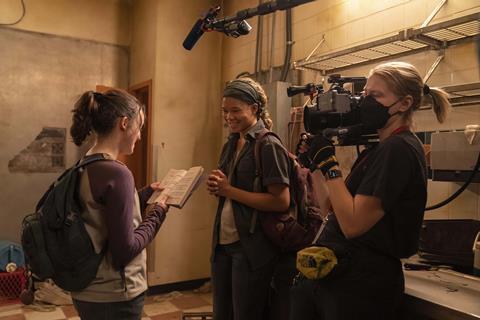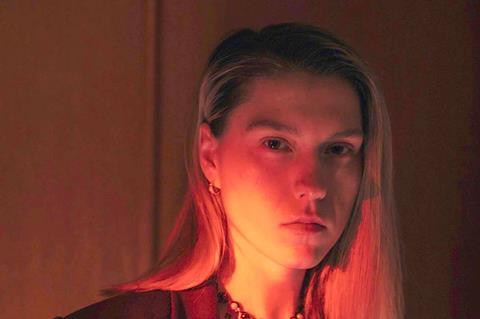Moscow-born cinematographer Ksenia Sereda on the incredible challenge of working on HBO’s hit video-game adaptation The Last Of Us.

Two summers ago, Ksenia Sereda made the most memorable and difficult car journey of her life. It was the middle of the night in Alberta, Canada, and she was crouched in the vehicle with actors Pedro Pascal, Gabriel Luna and Nico Parker. The driver was on the roof above, steering them through sheer carnage: panicking crowds, a burning building and, at the trip’s terrifying climax, a crashing plane. And here was Sereda, operating a handheld camera, capturing the end of the world as we know it in one single take.
She still cannot quite digest how it happened. “It was absolutely shocking and unbelievable,” says the Moscow-born cinematographer of being hired as DoP for three episodes of HBO Max’s prestige mega-hit The Last Of Us — including the look-defining pilot, which featured the aforementioned carpool to the apocalypse. “It was so surreal. It’s hard to express what I was feeling. It was like… a fairytale.”
Sereda’s astonishment is not merely down to being a huge fan of Neil Druckmann’s 2013 video-game source material, which the series follows closely on its post-apocalyptic journey of shady smuggler Joel (Pascal) and teenager Ellie (Bella Ramsey) who may carry the key to humanity’s survival. It is more to do with the fact that, at the time she was approached, Sereda had never worked outside Europe or Russia and did not even harbour an ambition to relocate “to Hollywood”.
“I was never excessively obsessed with moving to North America,” says Sereda, currently in Los Angeles prepping for a feature shoot on the east coast (she cannot reveal any details, she apologises), “because I was working on great scripts with great directors in Europe, and I think it is better to keep working with people you love.” She even confesses to not being sure exactly what drew Druckmann and his co-showrunner Craig Mazin (Chernobyl) to her, but strongly suspects it was Kantemir Balagov’s 2019 drama Beanpole, which is set in a Second World War-ravaged Leningrad and would certainly have suggested her ability to find beauty in widespread destruction. “It just happened,” she says. “But I do need to say that The Last Of Us is the happiest, most exciting and challenging experience I’ve had in my entire life.”
Sereda’s career to this impressive point appears to have been guided by fate rather than intention. “I cannot tell you a beautiful story of how I always thought I would be a cinematographer,” she says, laughing. “I wanted to be a linguist, but my native language is very complicated and I really couldn’t get it.” She then pivoted to her hobby, photography, before realising there were no higher education courses for that in her homeland. “But we did have higher education for cinematography, and I’d heard it was sort of similar. So I decided to try it.”
Holistic experience

Sereda fell in love with the craft as soon as she began studying at the All-Russian State University of Cinematography. “It is the most incredibly creative part of the film industry,” Sereda says. “I like how everything integrates into cinematography. It’s such a beautiful, holistic experience working with actors, working with characters, and building the visual language.”
It was after her first year of study, at the age of 18, that Sereda shot her first feature, 2014’s Bez Kozhi with director Vladimir Bek, getting the gig on the strength of her photography after two previous DoPs dropped out. Since then, Sereda has worked consistently on features and TV shows, mainly in Russia, until HBO came calling. “I think it was just meant to be,” she says.
The Last Of Us was quite a step up for someone so relatively young, working in North America for the first time. Sereda had participated in larger scale productions before, with stunt teams and visual effects. But, she acknowledges, “The Last Of Us is on a completely different level.” It has been described as the biggest TV production ever shot in Canada, bringing a reported revenue of $150m (c$200m) into the Alberta region, and furthermore, Sereda points out, “It’s based on one of the most incredible video games.” One she regards as “a piece of art — visually it is so strong and so cinematic”.
Sereda faced the distinct challenge of adapting a visually striking and immersive video game as the DoP who worked closely with Mazin and Druckmann to set the show’s visual style. She then shared “all the visual rules” with a further three cinematographers (Eben Bolter, Christine A Maier and Nadim Carlsen), as well as the show’s other directors (Sereda worked with Mazin on episode one, Druckmann on episode two and Liza Johnson on episode seven).
“In cinema we have very powerful tools to work with,” she explains, “but you do not have this interactive tool, which you have in video games. Here we needed to create the atmosphere for the viewer so they could get deeply emotionally connected to the characters, as you do in the game.” This she achieved through an emphasis on handheld cameras, long takes and single-source lighting, providing an intimacy and immediacy she felt the material deserved.
“It was a very big responsibility to work with this material and to create a different way of comprehending it,” she says. This was not a matter of slavishly replicating the game, Sereda insists, pointing out that her showrunners gave her “the freedom of suggesting and bringing ideas”.
However, she adds, it was important to preserve the game’s more iconic elements, with the aforementioned car ride a case in point.
“In the game, when you’re in the car you have the freedom to look around, with a 360 view of what’s happening outside. Technically, we can’t copy that sequence, but we took the idea of the camera being connected to Sarah [Joel’s daughter, played by Parker], where we explore with her what’s happening around her.” Shooting it all in a single take, meanwhile, “gives the opportunity to experience for the same amount of time what the characters experience. So picking this solution for the scene, we’re not copying it exactly, but we are preserving its iconic vibe.”
Achieving it, however, was an incredible challenge. “It was a bit scary,” Sereda admits. “Mostly because there were so many elements involved, with so many things happening. Also, we were shooting in summer, when the night is so short. You have so much to do. But I think it worked out.”
Career trajectory
Sereda’s career post-The Last Of Us appears to be working out, too. She seems comfortable in the North American industry, having gone on to work on Apple TV+’s Akiva Goldsman-driven thriller The Crowded Room, and her first US feature, biopic Rob Peace, directed by Chiwetel Ejiofor and based on Jeff Hobbs’ book The Short And Tragic Life Of Robert Peace. “Chiwetel’s incredible,” she says. “I was lucky to work with him as a director and as an actor, because he plays one of the characters. I’m excited for the world to see that.”
Given her eventful career has, by her own admission, remained unstrategised, it is not surprising to learn she has no plans at this stage to direct. “I’m not sure I have this ambition,” Sereda says. “I understand why other cinematographers transfer into directing, but I’m so passionate about this part of film creation. It is the biggest passion of my entire life. I cannot imagine doing anything else.”






![The Brightest SunScreen[Courtesy HKIFF]](https://d1nslcd7m2225b.cloudfront.net/Pictures/274x183/3/5/0/1448350_thebrightestsunscreencourtesyhkiff_312678.jpg)


















No comments yet